In the heart of Alaska’s awe-inspiring mountain ranges lies the captivating Iliamna Lake. It is a freshwater gem that has won the admiration of both anglers and nature lovers. Encompassing an impressive 1,600 square miles, Iliamna Lake holds the distinction of being Alaska’s largest lake. The size of Iliamna Lake is actually larger than that of Rhode Island. Fed by glacial waters, this beautiful lake is an ideal spot for those looking to reel in sizable fish.
The Tanaina Native Americans named the lake, which holds a rich historical significance. Today, Iliamna Lake remains a sought-after destination for fishing, boating, and venturing into the untamed Alaskan wilderness.
Location
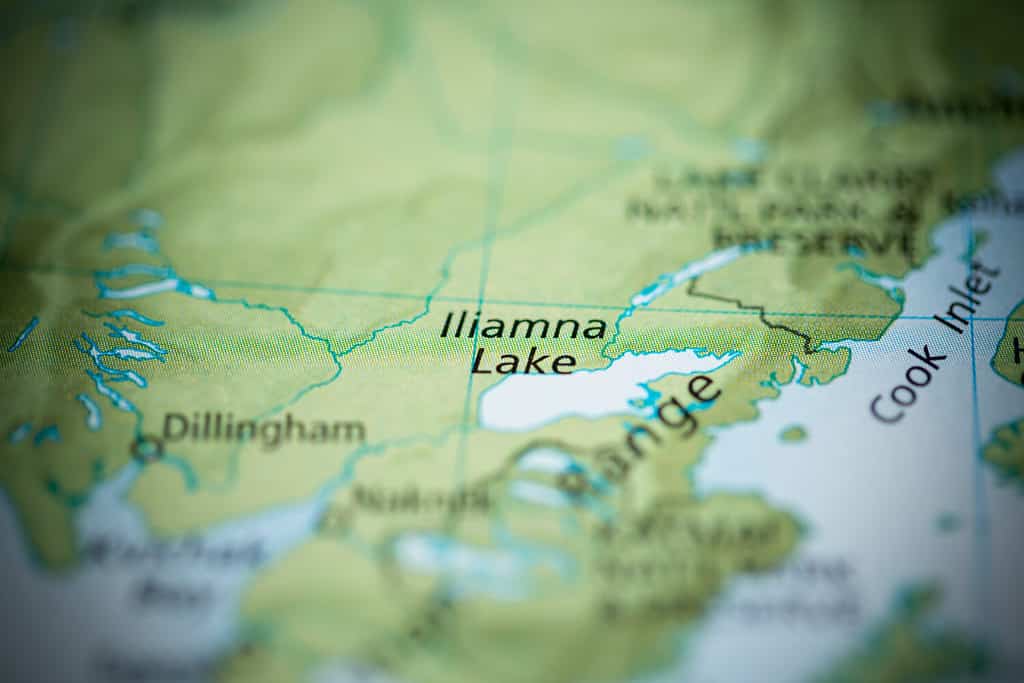
Two national parks surround Iliamna Lake, making the area a vast and beautiful place.
©SevenMaps/Shutterstock.com
Iliamna Lake is an impressive destination at the farthest northern point of the Alaska Peninsula, nestled between Cook Inlet and Kvichak Bay, approximately 100 miles from the town of Seldovia, AK.
At the northeastern edge of the lake, the formidable and active Iliamna Volcano stands tall at an elevation of 10,020 feet. This majestic volcano is adjacent to the Tuxedni Glacier, which flows into the lake. The Kvichak River serves as the primary outflow for Iliamna Lake, eventually flowing into Bristol Bay and out into the Bering Sea. The majority of residents in the quaint communities lining Iliamna Lake’s shoreline are native Alaskans. Tourism is a crucial economic lifeline for these communities. Iliamna, a town positioned on the lake’s northern coast, acts as a primary hub for visitors keen on experiencing the region’s breathtaking landscapes.
Where Is Iliamna Lake Located on a Map?
This lake is located in Alaska’s southwest, boasting a substantial inland body of water to the west of Cook Inlet, an arm of the Gulf of Alaska. Two famous national parks surround this captivating lake. They are Katmai National Park and Preserve to the south and Lake Clark National Park and Preserve to the north.
History
Iliamna Lake boasts a rich history that extends over thousands of years. Archaeological findings indicate that indigenous populations have inhabited the region for countless generations. The lake and its surroundings have consistently provided essential sustenance and resources for these communities.
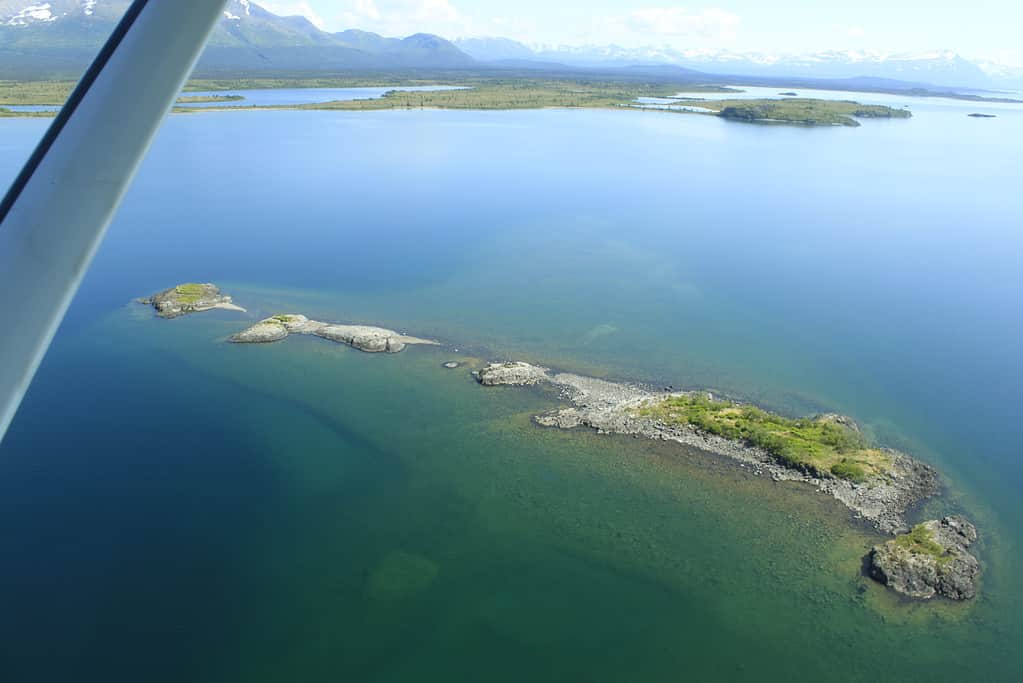
Archaeological findings indicate that indigenous populations have inhabited the area surrounding Iliamna Lake for countless generations.
©Nessie91/Shutterstock.com
Initially, an Athabaskan settlement, Iliamna, was where the Iliamna River met the lake. This settlement, about 40 miles east of present-day Iliamna, eventually became Old Iliamna. In the 1930s, the area saw the construction of its first sport fishing lodge, with another built in the 1950s.
The lake’s name has evolved over time. An early Russian map from 1802 referred to the lake as “Oz[ero] Shelekhovo” (Lake Shelekov) in honor of Russian explorer Grigory Shelekhov. However, its name is now Iliamna, which derives from the Inland Dena’ina Athabascan name Nila Vena, which translates to “island’s lake.”
The 20th century saw the expansion of commercial fishing and the development of transportation infrastructure. The construction of roads and an airstrip led to population growth and economic progress in the region. Today, Iliamna Lake and its surroundings are sought-after tourist destinations, offering outdoor activities like fishing, hunting, and hiking.
Size
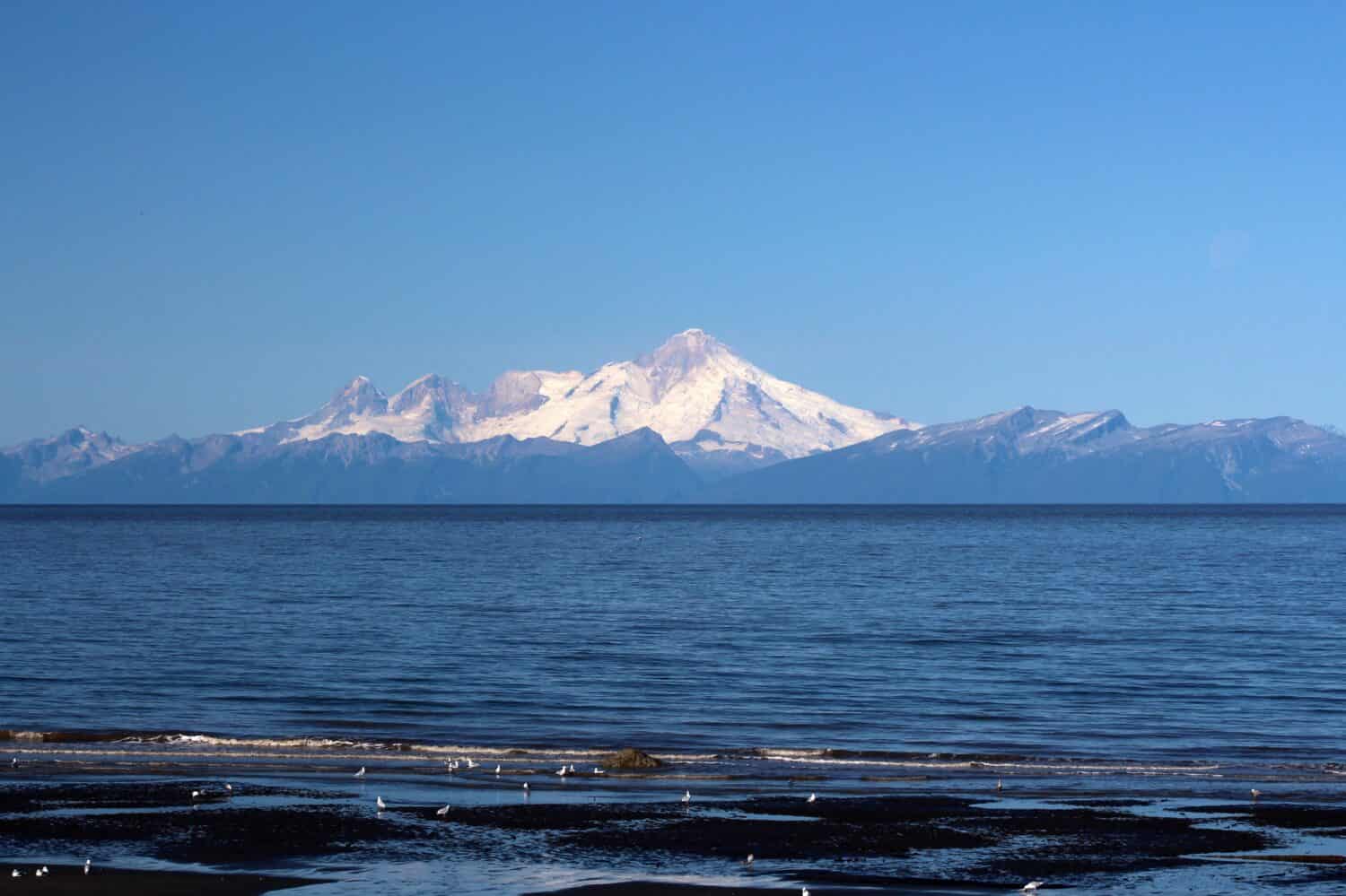
With an area of about 1,600 square miles, Iliamna Lake is Alaska’s largest lake.
©jet 67/Shutterstock.com
Iliamna Lake is a marvel of nature, celebrated for its striking size and impressive dimensions. Spanning a vast area of around 1,600 square miles, it holds the title of Alaska’s largest lake and ranks as the second-largest entirely within the United States. Among North America’s largest lakes, Iliamna Lake comes in as the 24th largest.
Measuring an impressive 77 miles long and up to 22 miles wide, the lake’s surface elevation reaches 46 feet. Its coasts are characterized by a remarkable 283 miles of shoreline, interspersed with over 173 islands throughout its vast waters.
Depth
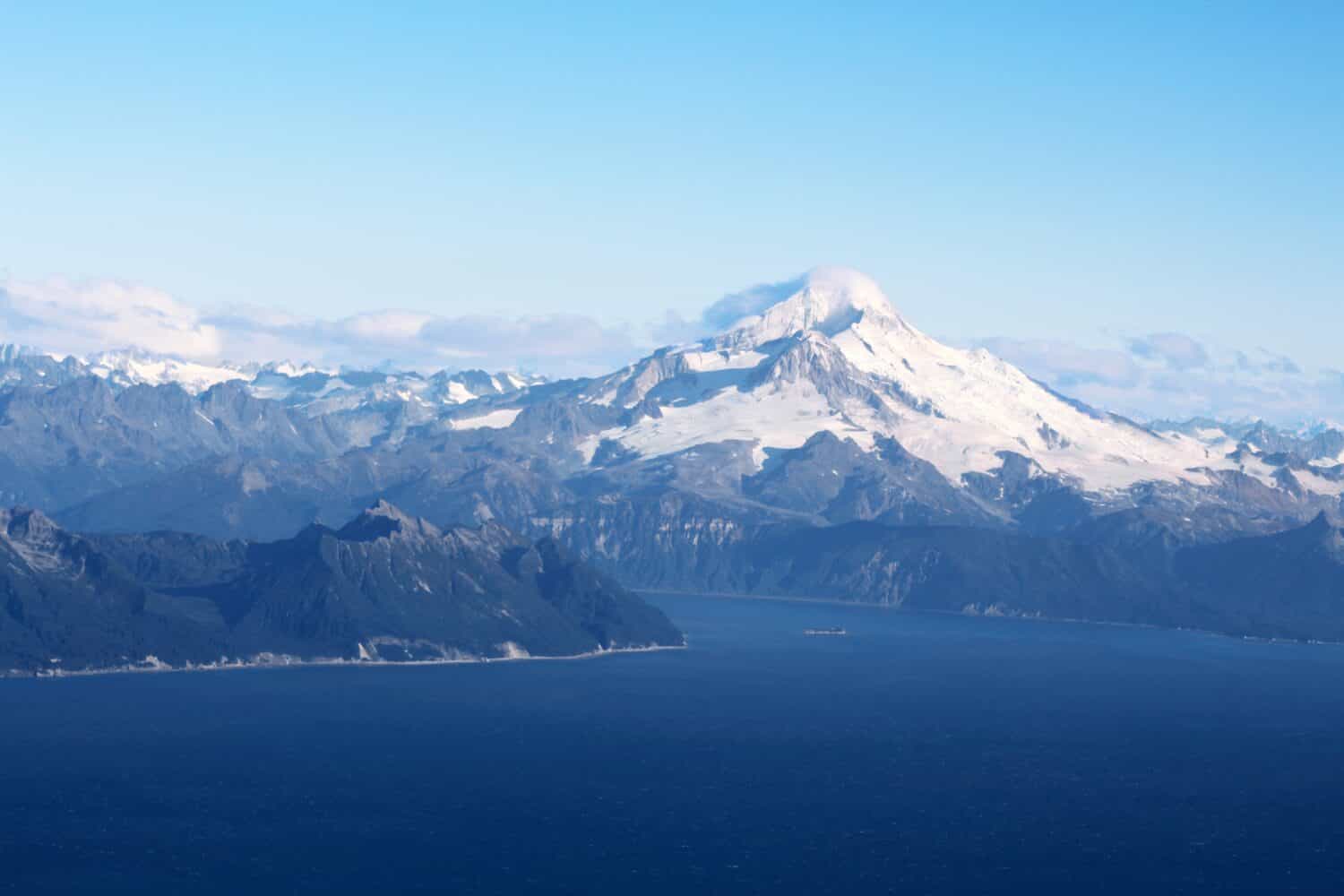
The average depth of Iliamna Lake is 144 feet.
©jet 67/Shutterstock.com
Iliamna Lake has a remarkable maximum depth of 988 feet, making it the sixth deepest lake in the United States.
The lake’s average depth of 144 feet is equally impressive, offering visitors a glimpse into the mysteries of its aquatic world. To put this into perspective, the average depth of Iliamna Lake is deeper than the height of a 10-story building!
Water Level
| Water Level at Iliamna Lake | Historic Crests | Recent Crests |
|---|---|---|
| Highest recorded | 78.42 ft on 10/01/2003 | 71.53 ft on 09/21/2016 |
| 2nd highest recorded | 71.82 ft on 06/08/1998 | 70.48 ft on 10/13/2013 |
| 3rd highest recorded | 71.53 ft on 09/21/2016 | 69.99 ft on 09/22/2012 |
| 4th highest recorded | 71.16 ft on 09/18/1999 | 68.07 ft on 08/07/2013 |
| 5th highest recorded | 70.93 ft on 11/06/2002 | 66.33 ft on 07/07/2015 |
Iliamna Lake’s water level can be influenced by ice, and forecasts for the Iliamna River near Pedro Bay are regularly issued during the warmer season and as necessary during other times of the year. The provided data offers a glimpse into the historical and recent crest levels for the lake, showcasing the fluctuations in water levels over time.
It is important to mention that no records exist for Iliamna Lake’s low water levels. While high water level records are available, the lack of low water level records indicates that the lake’s water level has remained fairly constant over time without significant drops.
This consistency could be attributed to several factors, such as the lake’s vast size, its connections to neighboring rivers and water systems, and the impact of local climate and weather conditions.
Fishing
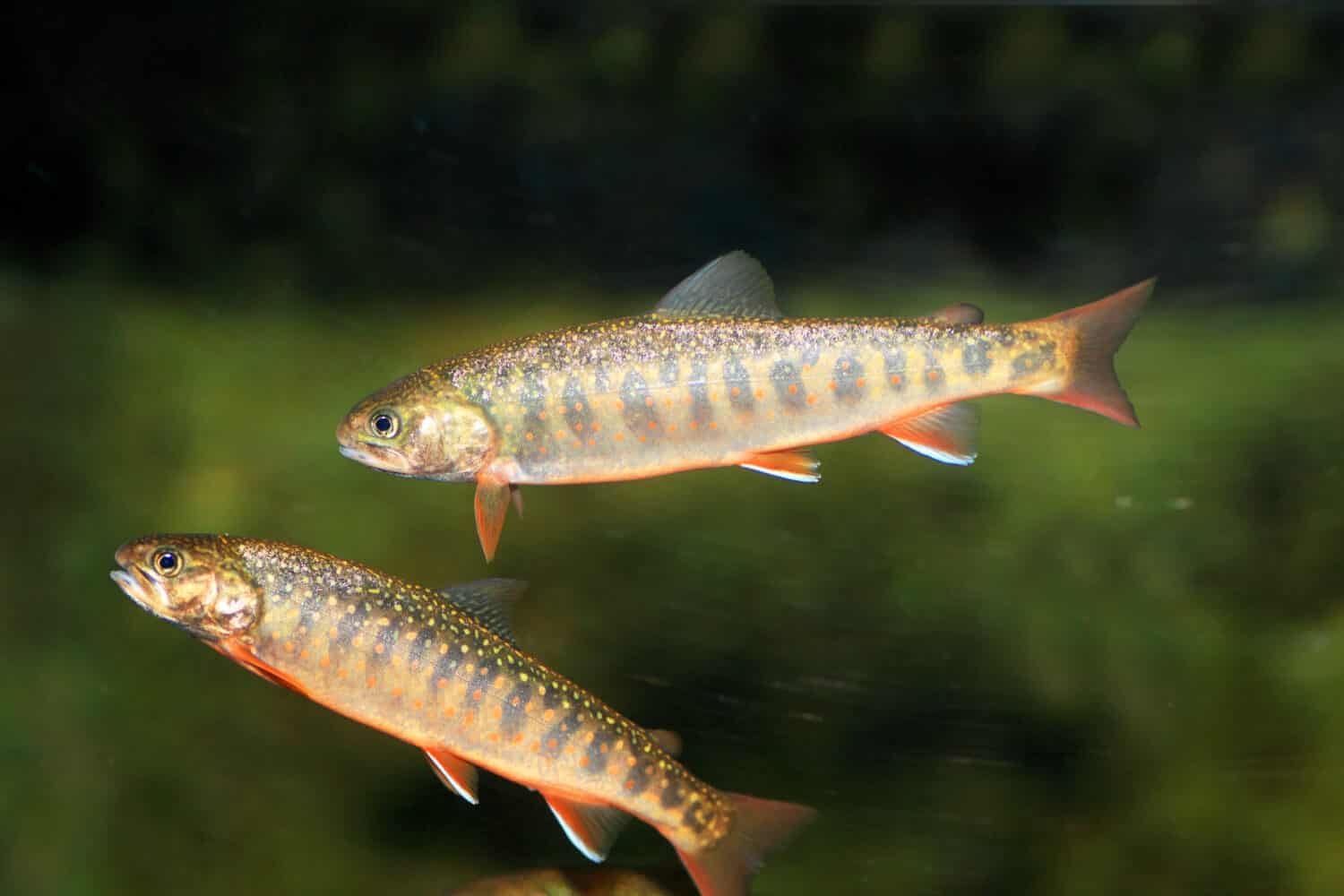
If you’re fishing at Iliamna Lake between July and September, you may catch Dolly Varden trout.
©feathercollector/Shutterstock.com
Iliamna Lake boasts one of the best fishing grounds in Alaska. Despite its legendary lake monster, the lake draws fishermen from around the country who come to cast their lines and test their luck.
The mysterious and elusive Iliamna Lake Monster is a topic of much intrigue and discussion among local residents. Numerous stories abound about this unknown aquatic creature, which has yet to be fully identified or understood.
Visitors today come to fish for a range of other species, including rainbow trout, pacific salmon, and arctic grayling. Furthermore, the lake is a catch-and-release haven for rainbow trout, with populations that grow to trophy sizes of 15-28 inches.
Fishing enthusiasts can expect king salmon to start their freshwater migration in May and to be in the lake by the first of June. These can be fished for until at least mid-July. Meanwhile, sockeye salmon also begin migrating in May, peaking from June to August. Silver salmon arrive a little later, beginning to migrate in July and peaking from August to October.
Dolly Vardens peak from July to September, while rainbow trout can be caught from April through October. Arctic grayling, on the other hand, peaks twice: once from April to June and again from August to October.
For avid anglers, Lake Iliamna is a paradise, offering a diverse range of fish species and fishing grounds. The lake is home to multiple lodges that specialize in fly fishing for rainbow trout, and its outstanding fishery draws visitors from far and wide. And if, by some chance, you hook the legendary lake monster, it too must be caught and released!
Geology
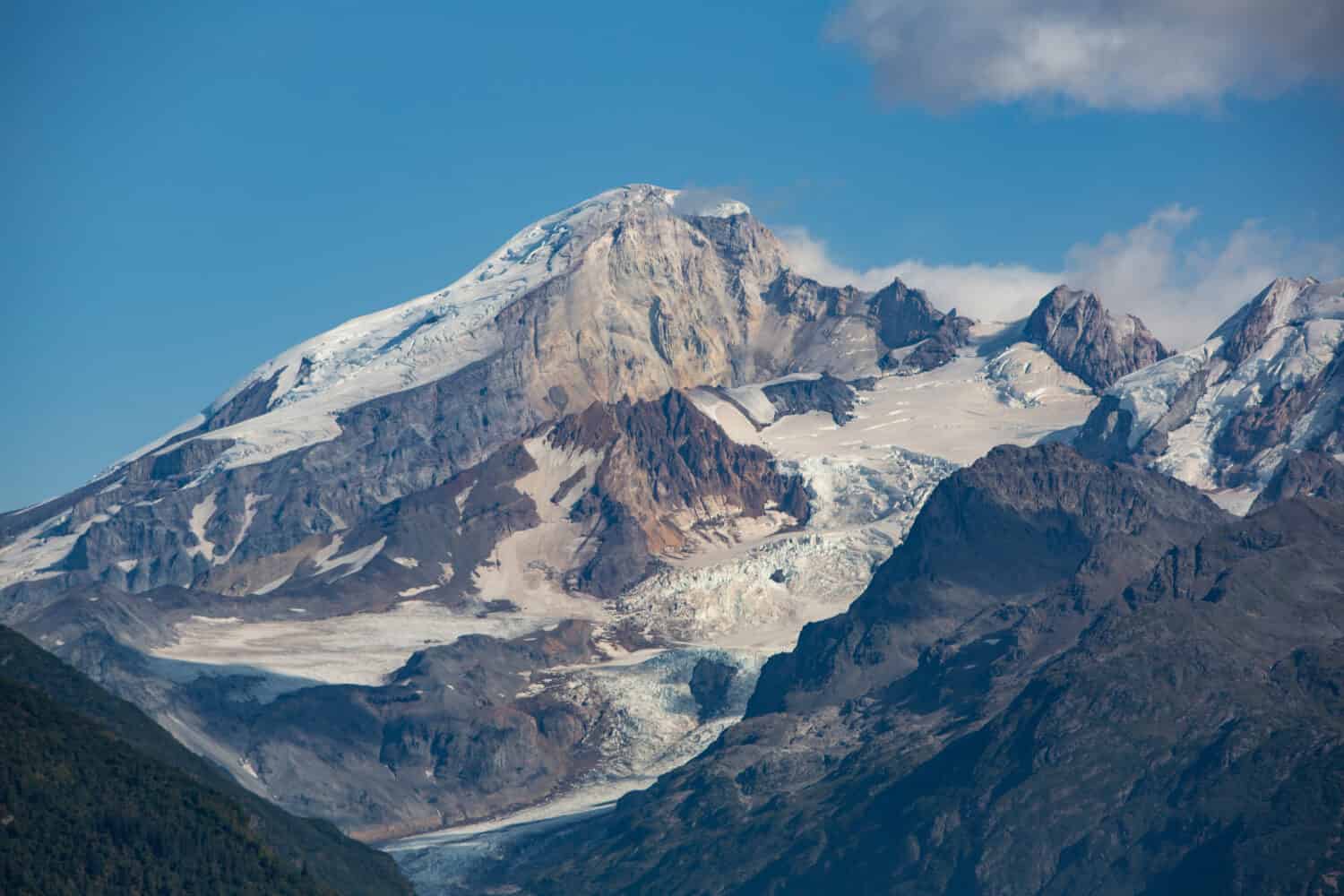
Northeast of Iliamna Lake is the Iliamna Volcano, or Mount Iliamna.
©Danita Delimont/Shutterstock.com
The Iliamna quadrangle, situated along the North Pacific Ocean, is a mobile belt featuring the active Aleutian volcanic arc. The area has remained tectonically active throughout recorded geologic history, with changes in elevation seen as recent as the 1964 earthquake. The quadrangle is rich in natural resources, and prospecting for gold, silver, copper, and petroleum was carried out here between 1893 and 1910. However, most activities ceased by 1915.
At the heart of the Iliamna quadrangle lies Iliamna Lake. The lake is believed to have been formed by glacial activity, as the Tuxedni Glacier carved out the valley in which the lake sits. Surrounding the lake is rugged mountain terrain composed mainly of volcanic and sedimentary rocks.
Notably, the active Iliamna Volcano, standing tall at 10,020 feet, is located northeast of the lake and has had a significant impact on the region’s geology.
Despite its size and depth, Iliamna Lake is classified as oligotrophic, meaning that it has low levels of nutrients and supports a relatively low level of biological productivity. This is due in part to the lake’s isolation from surrounding waterways. Nonetheless, the lake remains a unique and vital component of the Iliamna quadrangle’s geology and ecosystem.
Boating
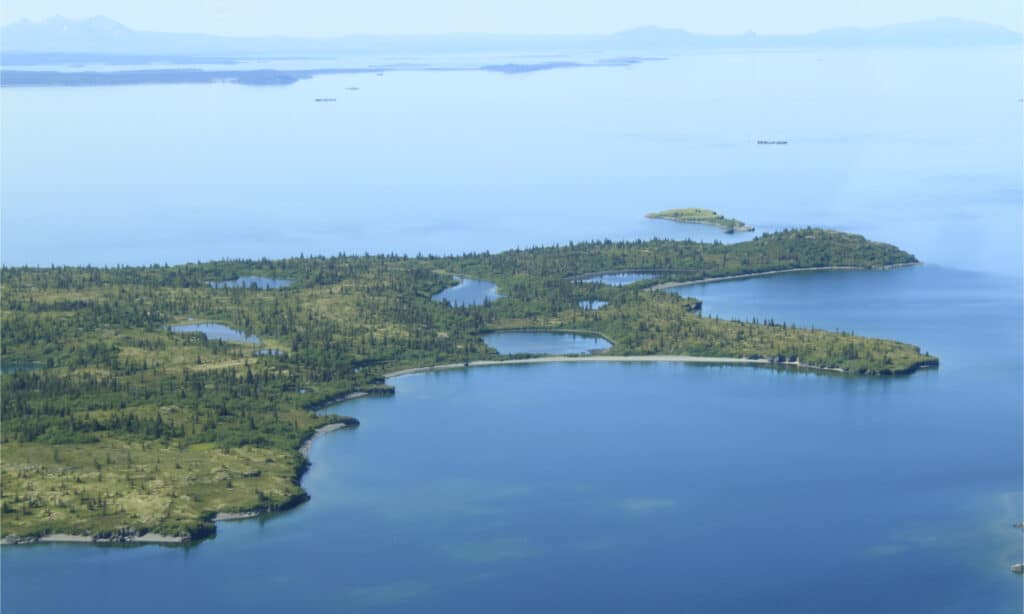
While boating is possible at Iliamna Lake, there are few boat launch sites available.
©Nessie91/Shutterstock.com
Engaging in boating, sailing, and kayaking on the lake is popular because of its vast expanse and stunning landscapes. Compared to other significant lakes in the United States, though, Iliamna Lake has fewer boat launch sites for guests. This, however, may be a plus for individuals seeking a more private and secluded aquatic experience.
Navigating Iliamna Lake demands care and planning, as the atmospheric and water conditions can be erratic. The lake may be subject to powerful gusts and turbulent waves, particularly during afternoons. It is recommended that those on boats consult the weather forecast and bring essential safety equipment like life vests and flares.
Sailing on Iliamna Lake is also feasible, but it necessitates a durable vessel and a skilled crew due to the lake’s dimensions and changeable conditions. Kayaking is a favored choice for people seeking a more serene and close-to-nature experience on the water.
Accessing Iliamna Lake and launching a boat might demand additional effort, but those who undertake this adventure will be rewarded with a singular and lasting experience.
Camping

While there are no designated campgrounds near Iliamna Lake, Rainbow King Lodge offers lodging with high-end amenities, including fly-in fishing excursions.
©Danita Delimont/Shutterstock.com
Embarking on a camping adventure at Iliamna Lake can be thrilling, but it is essential to mention that there are no designated campgrounds in the vicinity. Nevertheless, travelers have the option of staying at either Rainbow King Lodge or Iliamna River Lodge, both providing cozy lodging and awe-inspiring vistas of the Alaskan wilds.
Situated on the banks of Lake Iliamna, Rainbow King Lodge is roughly an hour’s flight from Anchorage. Despite its secluded location, guests can indulge in high-end amenities such as deluxe hotel-style bedding and HD TVs. The lodge also organizes fly-in fishing excursions for those eager to experience the unspoiled Alaskan terrain.
Another excellent choice for accommodations in the region is Iliamna River Lodge. This lodge has the capacity to host up to eight visitors and can be reserved exclusively for groups. With its magnificent views of the Iliamna River and surrounding mountains, the lodge is an idyllic spot for fishing enthusiasts and nature lovers.
Wildlife Watching

A large population of brown bears calls Iliamna Lake home.
©Tory Kallman/Shutterstock.com
Iliamna Lake is a true paradise for wildlife enthusiasts. Brimming with a diverse array of mammals and birds, it’s a captivating location that sparks the imagination. As you explore the region, you’ll be greeted by majestic eagles, gentle moose, graceful caribou, and elusive wolves. And that’s not all – the area is also home to the largest population of brown bears on the planet!
To maximize safety and enjoyment, consider enlisting the help of specialized guides when observing these amazing creatures.
But the wonders of Iliamna Lake don’t stop there. A remarkable feature of the lake is the presence of a small, rare population of freshwater seals – one of just two such groups in the world. These intriguing animals vanish from sight each winter as the lake freezes over, only to mysteriously reappear in the spring, despite being cut off from the rest of the world by the ice.
If you’re yearning for a thrilling, unforgettable wildlife adventure, Iliamna Lake should be at the top of your list.
The photo featured at the top of this post is © Nessie91/Shutterstock.com
Thank you for reading! Have some feedback for us? Contact the AZ Animals editorial team.






